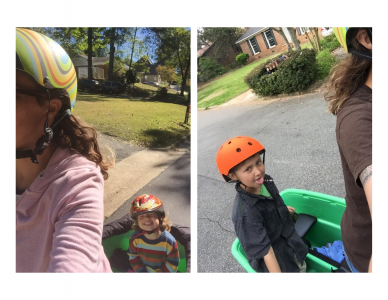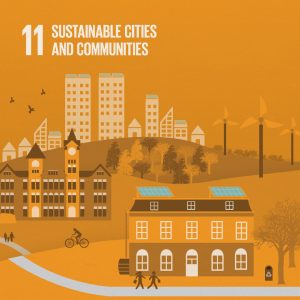by Rebecca Retzlaff, Director of the Academic Sustainability Program
Most of the people at Auburn who are involved in sustainability also have a personal commitment to living a sustainable lifestyle. Many of us try to walk the walk (or bike the bike) of what we advocate. While I wish that I could say that I have solar panels on my roof, or that I use a rainwater collection system, I unfortunately cannot. Most people don’t claim to have perfect sustainability practices, but everybody can try their best. For me, trying my best to be as sustainable as possible means foregoing driving my car as often as possible.

Becki’s children enjoying riding in a bucket bike.
I have commuted to work on my bike for over two decades. During that time I have made a few observations that I think could help other people who may be considering biking to campus:
Land uses make a big difference for bicycling: Planning for bicycle infrastructure and land uses are inseparable. Dense and mixed land uses make it easier to get places on a bike or by walking. For example, when my daughter was too young to bike herself to school, I used to bike her to and from school in a bucket bike (a bike with a big bucket on the back designed for carrying children). However, she often went to an after-school activity that was too far away to bike to in a reasonable amount of time, so we had to bike home after school and switch to a car to get to her activity. Technically, we could have biked there, because a bike lane ran almost the entire distance, but the land uses were too spread out to make doing so possible.
Get the right gear: Over my years of bicycle commuting I have figured out what I need to bike in all kinds of weather. My bike has racks on the front and back for carrying stuff, because wearing a backpack while biking often results in a sweaty back. I also have fenders on the front and back of my bike to keep rain and mud off my clothes. I keep rain pants, a rain jacket, and a waterproof backpack cover in a dry bag on my front rack, so I don’t show up to work drenched because I didn’t look at the weather in the morning. I have several lights on the front and back of my bike. You don’t need a fancy or expensive bike to ride to work. My bikes were all free and are all older than me. The bike that I usually ride is a 1970s steel Schwinn, which is the perfect commuting bike because it will never rust and will probably outlive me. I also have an older Dutch steel bike that belonged to my mom when she was young. My daughter, who commutes to elementary school on a bike, rides a pink 1983 Schwinn Fair Lady with a banana seat, the bike of my childhood dreams.
Bikes are not just toys, and are not just for exercise: One of the common misconceptions about bikes in Auburn is that they are just toys for children, or only for people clad in spandex riding 100 miles on a Saturday morning. Not true. Bikes (and bicycle infrastructure) are an essential part of a sustainable transportation network, and need to be treated as such. A bicycle infrastructure network designed for children, or for athletics, looks different than a network designed for people to get to work and shopping, but planning for bikes can accommodate all types of activities. Reframing the idea of bicycles as an essential (not alternative) mode of transportation, just like roadway lanes for cars, is essential to planning for a network of infrastructure that is used by people as an alternative to driving.
Students in Auburn’s Minor in Sustainability Studies often work on projects related to sustainable transportation, including bicycling. Student projects include mapping the campus bike network, recommending changes to the campus master plan, and analyzing the multi-use trails in Auburn. Many of our students are also personally committed to sustainability, and walk, bike, or ride the bus to campus every day. If you are interested in adding the Minor in Sustainability Studies to your degree, visit the Academic Sustainability Program webpage.
Learn about the SDGs & AU and our contributions related to this post.




